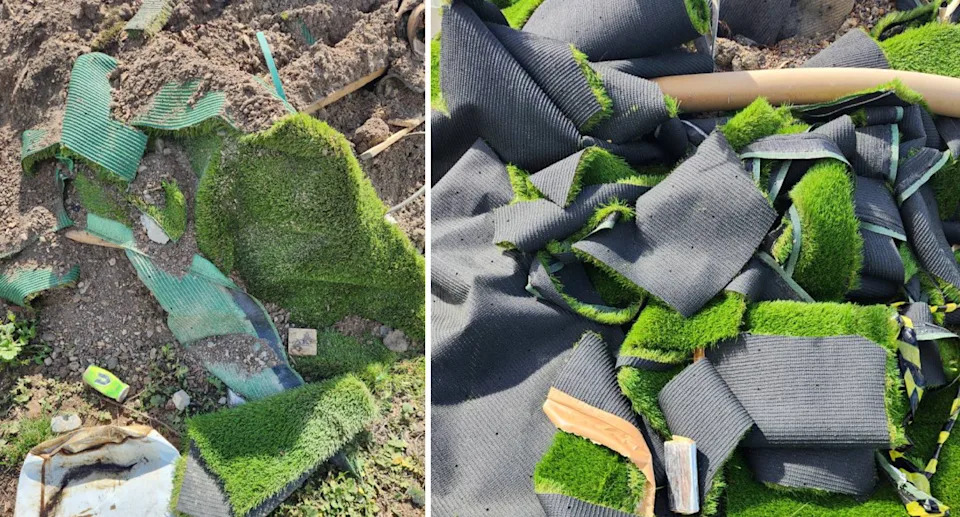A major regional council has proposed banning synthetic grass across nature strips and new homes, in a move in keeping with a broader national pushback against the artificial alternative.
The Queanbeyan-Palerang Regional Council (QPRC), in the New South Wales Southern Tablelands, has argued that the impact of artificial grass is both harmful to people and the environment, and is seeking community consultation ahead of the move.
The grass disintegrates into microplastics, which subsequently make their way into waterways — and can even potentially end up being inhaled by people, council said. It also contains PFAS (Per-and polyfluoroalkyl substances), which is “not good for our stormwater”.
“Artificial grass may contain microplastics and PFAS. As street verges are adjacent to the stormwater drainage system, restricting artificial grass in these locations reduces the risk of these affecting environmental and human health,” a spokesperson told Yahoo News.

Artificial grass was dumped by the roadside in Victoria last month. Source: Facebook/Kellie J.
“This is a growing area of research, particularly in an Australian context. The NSW Chief Scientist and Engineer released a review of synthetic turf in October 2022, which focused on synthetic turf used in public spaces and sporting contexts.
“[It] noted that both rubber infill and turf fibre blades from synthetic turf fields have been found in waterways. The review also noted that turf fields can be built and managed in such a way to reduce this impact on stormwater systems or waterways.”
Enjoying this story? Find more of Yahoo’s best content on our new-look homepage here.
Under the council’s new proposal, fake grass would be barred from being installed on new houses in the future. “The policy is currently on public exhibition until October 30 and has not yet been adopted,” the spokesperson added.
Do you feel strongly about the proposed artificial turf ban? Contact joe.attanasio@yahooinc.com
No fake grass in new home builds across Queanbeyan
However, they said it would be unfair to ban it completely straight away, as that would force existing homeowners to remove their artificial lawns immediately. “I think it would be unfair to say we’re going to ban it completely — unfair for all those houses that already have it,” QPRC Mayor Kenrick Winchester said, the ABC reported.
Instead, anyone who already has fake grass will be allowed to keep it, but once they choose to replace it, they won’t be permitted to install new synthetic turf.
While the council has made its views clear, locals argue there’s another side to the story. They say that artificial grass can, in fact, be more environmentally friendly than its natural alternative, using less water and requiring very little maintenance.
For residents who live in areas prone to erosion or on sloped blocks, synthetic grass is the more practical option, some argued.
The ACT Greens spokesperson for Climate Adaptation, Andrew Braddoc, is all for the ban. He would like to see it rolled out even more broadly, arguing that it’s “sold as a green product … but is anything but”.
The debate is one that several other councils across Australia have recently discussed. In Victoria, there are growing calls to ban the use of artificial grass in yards and public spaces, after mountains of the controversial product were dumped in a nature reserve.

Many negatives to artificial grass outweigh any sense of ‘convenience’. Source: TCD
Artificial grass debate heats up across Australia
Artificial grass impacts the environment long before it’s even ripped up, Dr Paul Cheung, who researches urban heating at the University of Melbourne, told Yahoo News.
“If you compare artificial turf to natural turf, artificial turf will absorb a lot of sunlight, and it will heat your backyard or sports ovals,” he said, explaining that it significantly contributes to the urban heat island effect. “This heat impacts the health of the residents, too.”
This week, Australia’s National Climate Risk Assessment was released by the government, and it reported some harrowing predictions of what Australians will face if global temperatures continue to rise. If global heating reached three degrees Celsius, which could happen close to the end of the century, heat-related mortality rates could rise by as much as 444 per cent in Sydney and 259 per cent in Melbourne.
“If we are anticipating a warmer environment in the future, we have to think of every opportunity to make our environment cooler,” Cheung said. Artificial grass is being incorporated into new housing developments across the country, and residents are also opting for the alternative of traditional grass to avoid watering, fertilising and mowing their lawn.
However, this “convenience” is an illusion, Cheung said. He explained that, as yards and public spaces are becoming increasingly hotter due to artificial grass, this needs to be constantly managed.
“People need to use plants and vegetation in their gardens to provide cooling benefits and shade the ground,” he said. “Irrigation [watering the areas] still needs to be considered, too.”
Love Australia’s weird and wonderful environment? 🐊🦘😳 Get our new newsletter showcasing the week’s best stories.


